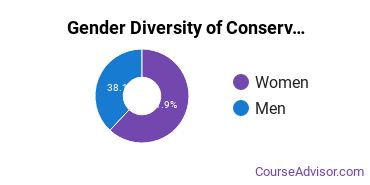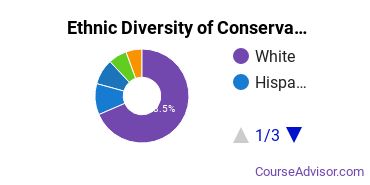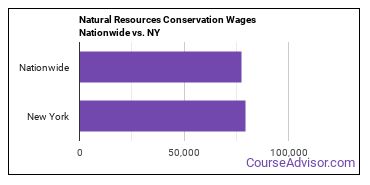Conservation Schools in New York
In 2022-2023, 1,360 students earned their Conservation degrees in NY.
In terms of popularity, Conservation is the 58th most popular major in the state out of a total 336 majors commonly available.
Education Levels of Conservation Majors in New York
Conservation majors in the state tend to have the following degree levels:
| Education Level | Number of Grads |
|---|---|
| Bachelor’s Degree | 1,066 |
| Master’s Degree | 143 |
| Associate Degree | 130 |
| Doctor’s Degree (Research / Scholarship) | 15 |
| Doctor’s Degree (Professional Practice) | 15 |
| Doctor’s Degree (Other) | 15 |
| Award Taking Less Than 1 Year | 6 |
Gender Distribution
In New York, a conservation major is more popular with women than with men.

Racial Distribution
The racial distribution of conservation majors in New York is as follows:
- Asian: 7.4%
- Black or African American: 3.0%
- Hispanic or Latino: 11.6%
- White: 66.5%
- Non-Resident Alien: 4.4%
- Other Races: 7.1%

Jobs for Conservation Grads in New York
6,130 people in the state and 119,200 in the nation are employed in jobs related to conservation.

Wages for Conservation Jobs in New York
In this state, conservation grads earn an average of $79,340. Nationwide, they make an average of $77,580.

Most Popular Conservation Programs in NY
There are 10 colleges in New York that offer conservation degrees. Learn about the most popular 10 below:
Of all the teachers who work at the school, 72% are considered full time. Students enjoy a student to faculty ratio of 13 to 1. This public college charges it's students an average net price of $20,059.
Request Information9 to 1 is the student to faculty ratio. An average student at Cornell will pay a net price of $29,651. 91% of the teachers are full time.
Request InformationSeeking financial aid? At this school, 80% of students receive it. 75% of the teachers are full time. It takes the average student 4.14 years to graduate.
Request InformationThe average student takes 4.13 years to complete their degree at Columbia. Students enjoy a student to faculty ratio of 6 to 1. 57% of students get financical aid.
Request InformationOf all the teachers who work at the school, 93% are considered full time. An average student at Colgate will pay a net price of $24,052. Seeking financial aid? At this school, 46% of students receive it.
Request Information61% of the teachers are full time. The average student takes 4.29 years to complete their degree at SUNY Brockport. Seeking financial aid? At this school, 91% of students receive it.
Request InformationThe student to faculty ratio is 14 to 1. Of all the teachers who work at the school, 42% are considered full time. Seeking financial aid? At this school, 100% of students receive it.
Request Information96% of students are awarded financial aid at this school. This private institution charges an average net price of $29,256. The student to faculty ratio is 8 to 1.
Request Information96% of students are awarded financial aid at this school. The full-time teacher rate is 100%. The student to faculty ratio is 14 to 1.
Request Information64% of the teachers are full time. This public college charges it's students an average net price of $19,592. Students enjoy a student to faculty ratio of 12 to 1.
Request InformationConservation Careers in NY
Some of the careers conservation majors go into include:
| Job Title | NY Job Growth | NY Median Salary |
|---|
Related Majors in New York
Below are some popular majors in the state that are similar to conservation.
| Major | Annual Graduates in NY |
|---|---|
| Natural Resource Management | 154 |
| Forestry | 100 |
| Wildlife Management | 55 |
| Fisheries Sciences | 28 |
View all majors related to Conservation
Explore Major by State
Alabama
Arkansas
Connecticut
Florida
Idaho
Iowa
Louisiana
Massachusetts
Mississippi
Nebraska
New Jersey
North Carolina
Oklahoma
Rhode Island
Tennessee
Vermont
West Virginia
View Nationwide Conservation Report
References
- College Factual
- National Center for Education Statistics
- O*NET Online
- Image Credit: By Lynn Betts under License
More about our data sources and methodologies.










